As a gardener, you’re undoubtedly familiar with that perpetual question when you find that something has been nibbling on your greens:
Are they safe to eat?
In many cases, yes, they are perfectly edible and you need not worry. However, at other times, the answer is absolutely not.
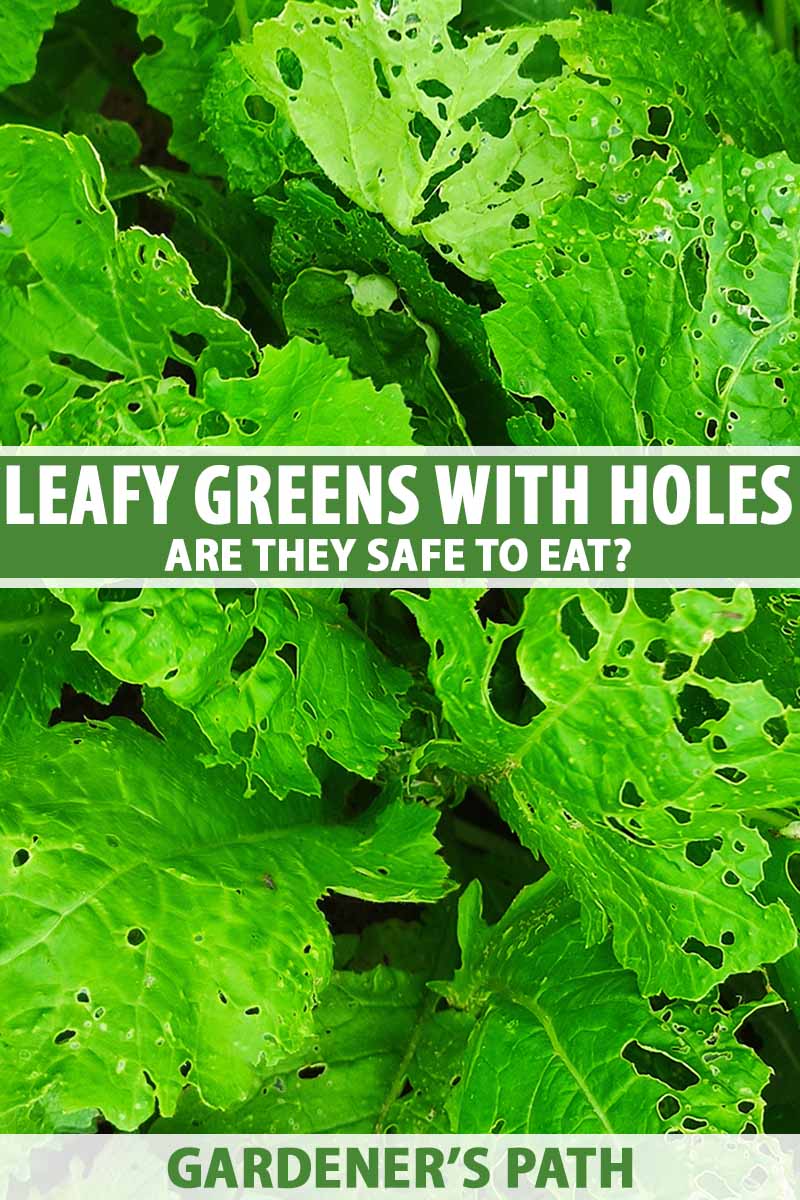
We link to vendors to help you find relevant products. If you buy from one of our links, we may earn a commission.
We will walk you through these different scenarios, so you will know whether or not you can eat the damaged fruits of your labor.
What You’ll Learn
Are Greens with Holes in Them Safe to Eat?
If you pick the leafy vegetables that you so lovingly tended through the season, and you discover that something – or someone – has been enjoying their own feast before you had a chance to harvest your crops, are they safe to consume?
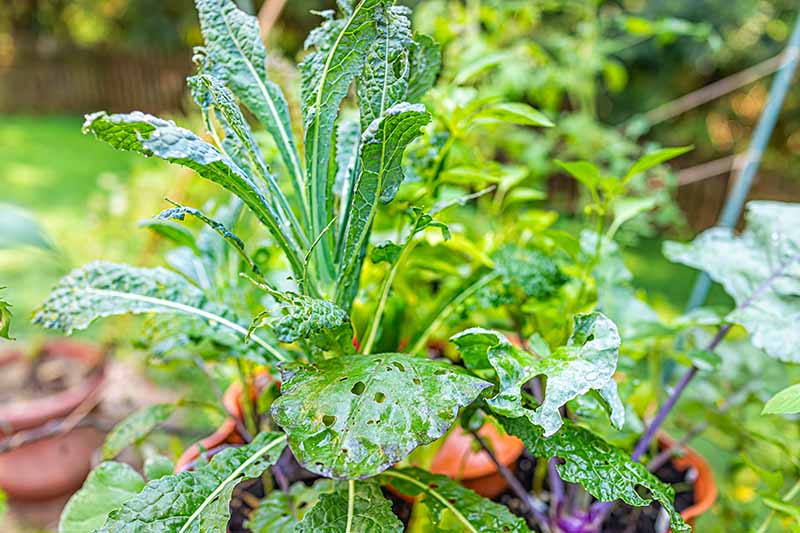
Fortunately, there’s good news!
Greens with holes in them that were created by feeding insects or slugs should be fine to eat, if you cut away the damaged parts.
However, there are times when you do want to avoid produce that has been damaged by the local wildlife. Let’s take a look.
When to Avoid Greens That Have Holes
If you are particularly unlucky, it is possible to become gravely ill from eating damaged greens.
In your vegetable beds, check the ground nearby to look for signs that a mammal may have been nibbling on the leaves.
If you find piles of deer or rabbit poop in the vicinity, do not eat the greens.
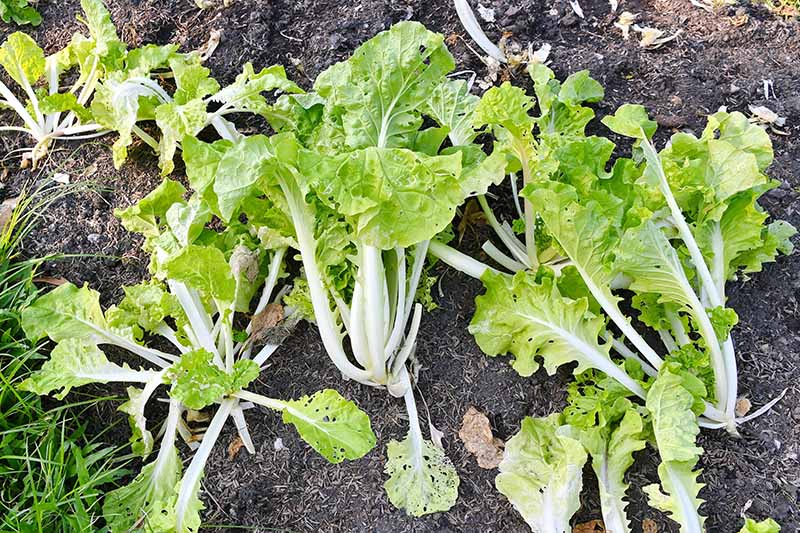
These animals can spread dangerous strains of E. coli (the “lab rat” of bacteria and a common ingredient in feces), as well as Salmonella.
While most strains of E. coli are harmless, there are strains that produce a toxin that can prove fatal to susceptible individuals like young children and the elderly.
Deer can be carriers of these strains. The toxin that these bacteria produce can be inactivated by heating food to 158°F, but why take a chance?
I think it’s far better to forego part of your crop than it is to risk your health.
Cat droppings can also pose a health hazard. They can spread the parasite that causes toxoplasmosis.
While toxoplasmosis infections often pass without causing any symptoms, they can cause serious problems for pregnant women, and have been found to cause mental illness in some cases.
Some gardeners report using soiled sheep bedding in the garden to keep the cats away, but that will not be practical for most people.
However, the principle should work for other types of animal bedding that contain urine, so if you keep farm animals on your land, you are in luck!
Beyond the realm of mammals, lizards kept as pets commonly spread Salmonella, though it is not clear whether wild lizards are a threat in the veggie patch.
However, according to Anna Rovid Spickler, veterinary specialist from the Center for Food Security and Public Health, “all reptiles can be sources.” It may behoove you to err on the side of caution if you find lizards in your garden as well.
Never Eat Raw Slugs or Snails
While escargot is not for everybody, I occasionally enjoy eating large snails cooked in butter and garlic. I feel like I am taking revenge on their brethren, who ravaged my delphiniums…
However, raw snails are another matter.
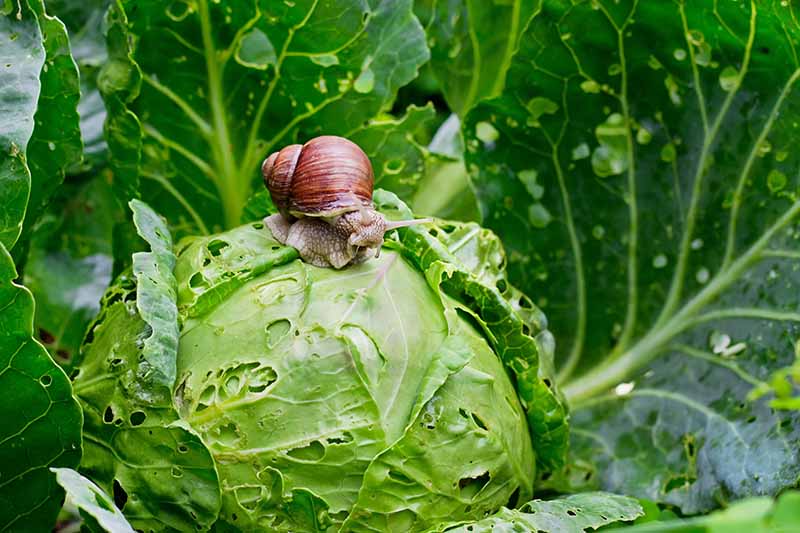
You may have caught the news story in 2019 about a 19-year-old Australian rugby player who ate a slug on a dare, and ended up paralyzed after coming out of a 420-day coma.
It is rare, but snails and slugs can harbor a nasty disease called rat lungworm that they pick up from rat droppings.
In humans, this parasite often dies out on its own. However, in rare cases, it travels to the brain and causes a form of meningitis. This can result in paralysis, and eventual death.
Rat lungworm is primarily a disease of the tropics, notable in various locations including Hawaii.
The pathogen was a known presence in southern Florida, but researchers were alarmed in 2018 when they discovered how widespread rat lungworm had become in Florida.
And the organism has been found in Louisiana and Texas as well.
Given the ever-warming temperatures that we now experience due to climate change, experts believe it is just a matter of time before this parasite spreads throughout the continental US.
Because these gastropods like to feed on tender garden greens, be sure to always clean your harvest thoroughly to remove any pests that may still be present before enjoying your salad.
Treat Your Leafy Greens Carefully
If you are pretty sure the holes in your leafy vegetables were caused by insects or slugs, they should be safe to eat, as long as you wash them thoroughly, and remove any damaged portions.
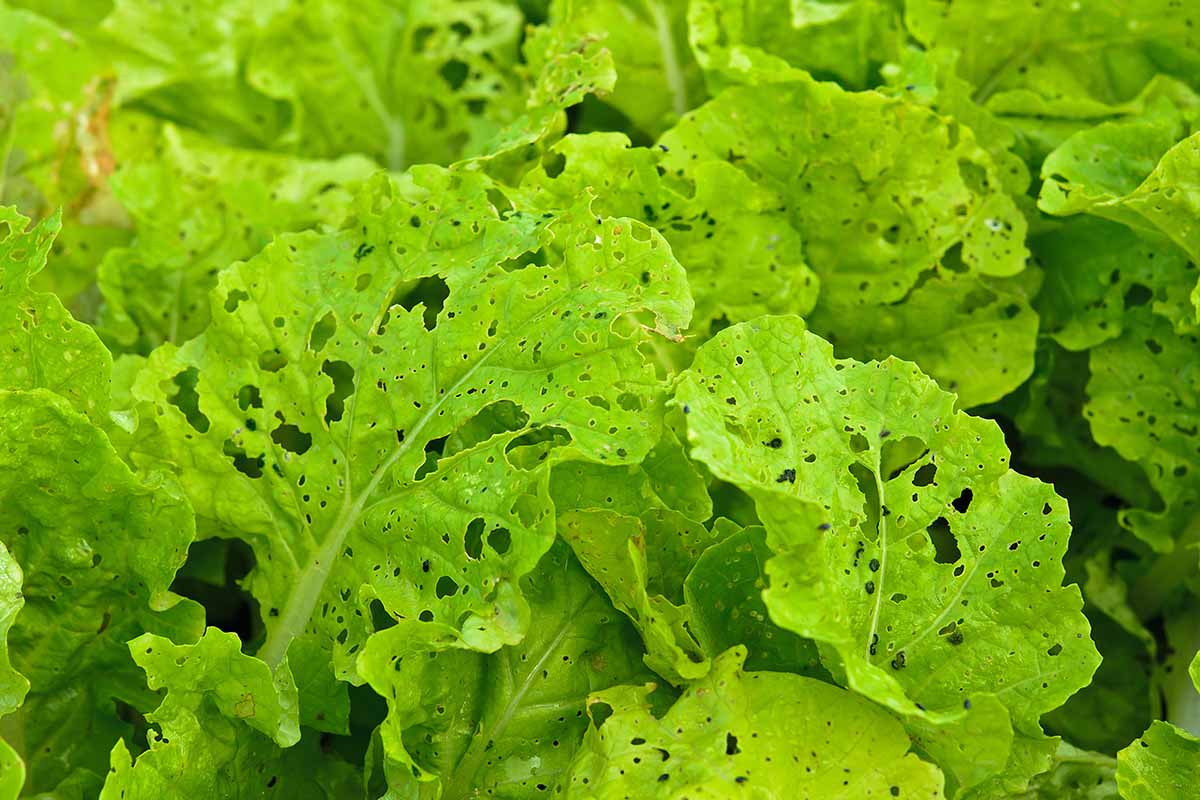
However, if mammals have been through your garden, you should avoid damaged greens.
Check your lettuce, kale, or spinach thoroughly for snails or slugs, especially if you live in the South or in Hawaii.
What has your experience been with bug holes in your Romaine, collards, or kale? Do you play it totally safe when you note signs of damage? Let us know in the comments!
And read on for more information on growing leafy green vegetables in the garden:
Thank you for this! It is great to find info from such an educated writer. Since I got my holey chard from the farmers market, I have no idea who was eating the voluptuous and vibrant leaves. So they will be going to the green bin. Much appreciation.
Yey an expert to listen to question! I find in every romaine leaf spine or back a complete hole running vertically?? Is this because of worms!
Can you share a photo, Nancy? Do the plants look healthy otherwise, and do the holes show any signs of burrowing insects, or frass left behind?
Slugs and caterpillars will typically chew uneven, irregular holes in the leaves, leaving the stems alone. Stem borers (like squash vine borers and European corn borers) may cause damage similar to what you’ve described, but these typically prefer squash relatives as host plants. Corn earworms could be the culprit – these larvae may burrow into heads of lettuce, or stems.
the kale has issues with aphids in the garden and in the organic grocery store. Soapy water on the undersides helps. If there are not many holes, I carefully wash off the aphids and eat it.
Hello Catherine! I completely agree with the approach of washing aphids off of only slightly damaged leaves and eating them anyhow! Just for anyone who’s not in the know, though, I would caution gardeners to only use insecticidal soap that is foodsafe and to follow the directions carefully outdoors. Don’t use any products that contain bleach or ammonia, for example. Thanks for sharing encouragement about eating kale that aphids have already helped themselves to!
I’m glad to learn more about this matter. I used to assume that greens with holes in them were spoiled and needed to be thrown away.
Now I have been getting the best of my greens so long as there isn’t mammal waste present. It certainly beats the pesticides on grocery store produce!
I have no interest in eating raw slugs or snails lol!
I’m glad the article was helpful Chelsea, I agree, definitely don’t want to eat raw slugs and snails!
I only eat cooked snails. I wonder if slugs could be used like escargot?
So, Brent, on the off-chance you’re not joking (you are joking, right?) I want to point out that slugs are in fact edible…technically, that is. But if you do decide to eat them, note that in rare cases consuming slugs can infect people with Angiostrongylus cantonensis, a parasitic worm passed to slugs when they feed on rat feces containing the larvae. (Hey, you started this topic, not me…). While this “rat lungworm” is not serious and usually clears up without treatment, the CDC still recommends cooking any slugs you want to eat thoroughly and wearing protective gloves anytime you handle… Read more »
Meh, after living in east Asia for over a decade I can eat anything that swims, flies, walks, crawls, or slimes its way through life. The guy on the first season of “Alone” pretty much won the show through a diet of slugs.
That being said, we are not endorsing slug eating nor are we responsible for anyone eating said gastropods or the results of such a culinary indulgence.
Can I eat collard greens once I wash off the whitefly eggs out of it? Please help me.
You can, if you’ve ensured that they’re free of pests! Otherwise, you may want to remove the infested portions and eat the rest.
This is probably a dumb question. New gardener here…….but When you say, “Greens with holes in them that were created by feeding insects or slugs should be fine to eat, if you cut away the damaged parts”, do you mean to cut off the holey parts of the leaves??
Hi Jade, there’s no such thing as a dumb question! Yes, if the damage is created by pests, then it’s fine to eat the greens, just cut off any parts of the leaves that have holes in them.
I agree that there is no such thing as a dumb question”
I just found countless holes and green worms located on the back side of the leaves on my collard greens that appeared as a surprise. a week ago I had neighbors taking pictures of my crop.
I pulled out the most beautiful trees I’ve ever seen since i did not know the cause.
I sprayed Clorox on the leaves before pulling the trees.
But there are two trees that were spared what do I do?
Using bleach on plants is not recommended in the garden – but I guess you mean you sprayed the ones you pulled before putting them in the trash?
If the plants that were spared are ready to harvest, your best option is to pick them right away. Otherwise, see our guide to growing collard greens for tips related to pest identification and management. These are likely cabbage worms. Good luck!
A good question. My issue is that the turnip greens I got from the local farmer are riddled with hundreds of teensy little holes. There is no part that is not “holey” because the damage is so dispersed. So I wonder whether there is anything unhealthy about eating these turnip greens cooked.
This sounds like it’s probably flea beetle damage. As long as the greens are free of pests and they still appeal to you, you can probably cook and eat them safely. But our general recommendation is to remove the damaged portions of pest-infested greens.
Thank you for the article. My cabbage is ready to harvest. However it is covered in poop from cabbage worms. I pulled off all the worms I could find but am grossed out by the layer of poop. Is it safe to eat?
Hello Vickie. I’m not sure you’ll be able to accept this advice if you’re thoroughly grossed out, but yes, you can eat the cabbage after a thorough wash of the leaves. I would start out by rinsing the leaves with the hose so you don’t have that image of caterpillar poop in your sink or strainer, and then rinse it again once you’re inside. The only qualifier: Don’t eat the leaves if the damage also includes rotting spots, discoloration of more surface than you can quickly cut off, or lots of holes. But if the cabbage worms created just a… Read more »
The leaves shown in this article are so FULL of tiny holes, it’s impossible to cut away the damaged parts – each entire single leaf is full of holes! Therefore the entire leafy plant has to be discarded!
It would have been helpful to show a leafy vegetable which damaged parts that could be cut away and the rest be safe to consume!
I have had to get rid of all my kale and cabbage and greens because they were all being eaten , full of holes even with bug killer so I don’t think they would have been safe to eat . A lot of work for nothing . There have been an influx of snails in my garden this year. 🫣